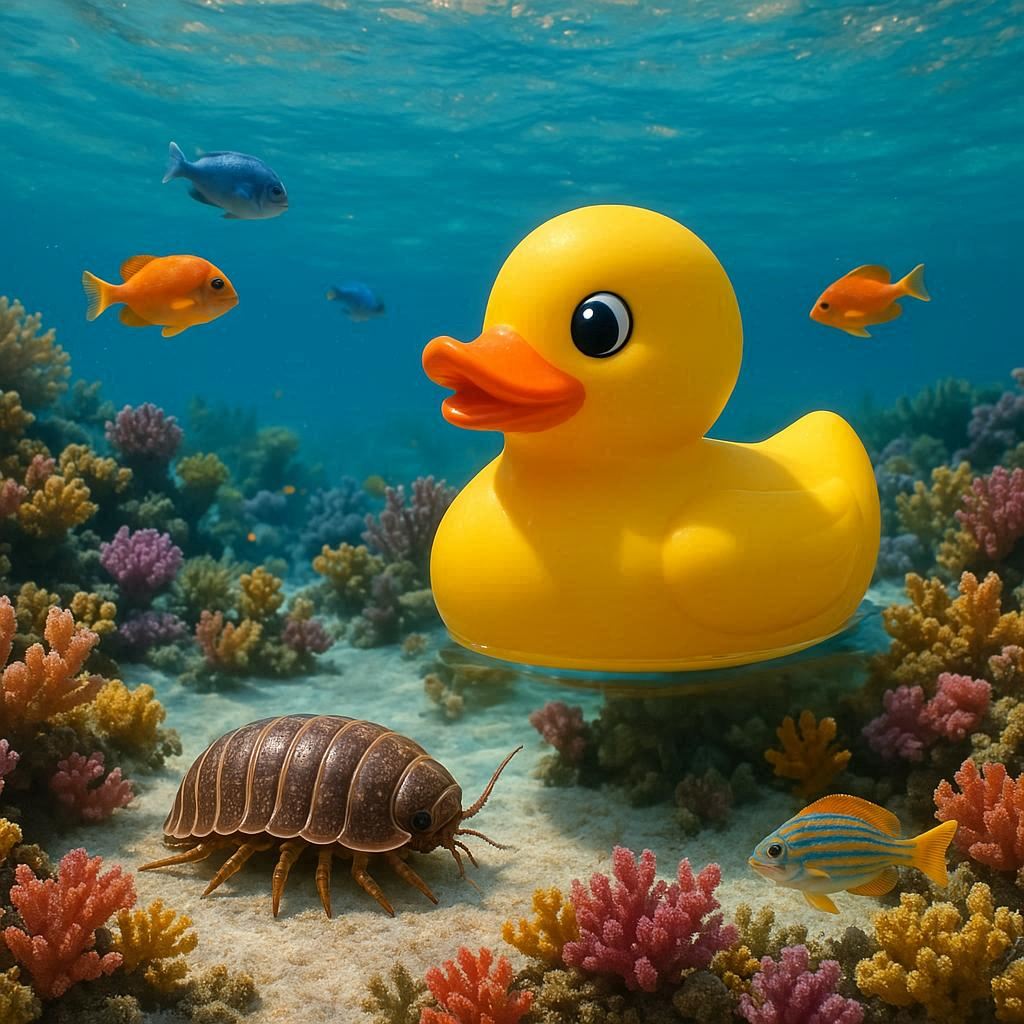Rubber Ducky Isopod: The Ultimate Care & Hobby Guide (2025 Edition)

Introduction
Rubber ducky isopod is one of the most captivating isopod species among hobbyists. With a face that resembles a little rubber duck toy, this isopod has become a sought‑after addition for terrariums, bioactive setups, and isopod enthusiasts. In this guide, we’ll explore species background, habitat requirements, enclosure setup, diet and supplementation, breeding, common problems, morphological varieties, and tips for both new and experienced keepers. If you’ve been curious about raising rubber ducky isopods or expanding your isopod collection, this article will walk you through everything step by step.
What Is the Rubber Ducky Isopod?
Species & Taxonomy
Rubber ducky isopod belong to the genus Cubaris (often listed as Cubaris sp. “Rubber Ducky”) and are among the undescribed or semi‑described species used in the isopod hobby.
The nickname comes from the bright yellow (or golden) cephalothorax (head region) which gives the appearance of a stylized rubber duck.
Because it is still relatively new to the hobby, much of the knowledge about its ecology is derived from captive observations and anecdotal reports.
Natural History & Origin
-
This species is believed to have been discovered in cave or limestone habitats in Thailand.
-
Their wild habitat likely includes high humidity, limited airflow, and limestone (calcium-rich rock) substrates.
-
They tend to be slower breeders compared to more common isopods, meaning colonies may take more time to grow.
Why Keep a Rubber Ducky Isopod?
-
Exotic appearance: Their yellow “duck face” is visually striking and unique in the hobby.
-
Conversation piece: Among isopod keeps, rubber duckies often draw attention and spark interest.
-
Bioactive & cleanup crew role: They can assist in breaking down leaf litter and organic waste in terrariums, though slowly.
-
Challenge & learning curve: They’re considered moderate in terms of care difficulty, making them a rewarding species to work with.
Rubber Ducky Isopod Care Requirements
Caring for rubber ducky isopod involves maintaining a delicate balance of humidity, substrate, diet, and microclimate. Below are the key factors:
Temperature & Humidity
-
Temperature: Aim for ~22–27 °C (72–80 °F).
-
Humidity: High humidity is essential. Maintain ~75 % to 90 %.
-
Avoid rapid temperature or humidity swings; these stress the isopods.
Enclosure & Setup
| Component | Recommendation | Notes |
|---|---|---|
| Enclosure | Waterproof storage bin (e.g., 12‑quart), or a terrarium box | 11.4 L bin works for a mid-sized colony |
| Ventilation | Minimal vents (mesh) | Rubber ducky isopods prefer low airflow |
| Substrate depth | At least 4 in (10 cm) | Provide depth for burrowing |
| Substrate mix | Organic soil + leaf litter + crushed limestone + charcoal/rotting wood | You want a moist, calcium‑rich, stable substrate |
| Wet / Dry zones | Create a “wet side” and a “dry side” | Use sphagnum moss on wet side; about 20–25 % of the bin area |
| Hides & cover | Cork bark, hardwood pieces, leaf litter | Provide hiding and foraging spaces |
Diet & Supplementation
Rubber ducky isopods are detritivores (feed on decaying organic material) but benefit from supplemental nutrients:
-
Staple food: leaf litter, decayed wood, dead plant material.
-
Protein/carb sources: dried fish, minnows/shrimp flakes, or commercial isopod diets.
-
Calcium / minerals: crushed cuttlebone, limestone, oyster shells.
-
Always replace leftover food to avoid mold or mites.
Water / Moisture
-
Mist lightly but maintain damp substrate.
-
The “wet zone” should stay moist but not drenched.
-
Avoid standing water; the bin should not leak or be over‑saturated.
Setting Up a Rubber Ducky Isopod Colony (Step‑by‑Step)
-
Choose the enclosure: A 12‑quart bin or terrarium with minimal airflow holes.
-
Create a substrate base: 4–6 inches of substrate mix (soil, leaf litter, crushed rock).
-
Divide zones: Mark ~75 % “dry” zone, ~25 % “moist” zone with moss.
-
Add hides: Cork bark, wood bits, leaf litter on top.
-
Introduce calcium sources: Place crushed cuttlebone or limestone pieces.
-
Mist & stabilize humidity: Use a spray to moisten but avoid flooding.
-
Introduce isopods: Start with a small breeding group (e.g. 10–20).
-
Feed appropriately: Scatter leaf litter, bits of wood, occasional protein.
-
Maintain environment: Monitor humidity, temperature, check for mold or pests.
-
Eventually expand / split: Once colony grows, you may divide into two bins.
Breeding & Growth
Rubber ducky isopods breed more slowly than some other isopod species.
-
Maturity: They take time to mature; no fast breeding bursts are typical.
-
Gravid females: You may see females carrying young in their brood pouch (marsupium).
-
Population growth: Growth is gradual; patience is key.
-
Colony splitting: When numbers exceed space, gently divide into a second bin.
Varieties & Color Morphs
Rubber ducky isopods show color variety and morphs, which are often sought after by collectors:
-
Standard “Yellow / Golden”: Typical bright yellow cephalothorax.
-
“Blonde Duckies” / pale yellow: A lighter color variant.
-
White / albino morphs: Rare morphs with white or pale features.
-
Other Cubaris morphs: Some enthusiasts compare with “Panda”, “Amber”, etc.
Because these morphs may carry slight differences in care sensitivity, handling them gently and monitoring for health is important.
Common Challenges & Troubleshooting
| Issue | Symptom | Possible Cause | Remedy |
|---|---|---|---|
| Mold or fungus growth | Visible mold patches | Overly wet substrate or poor ventilation | Reduce excess moisture, improve airflow slightly |
| Low reproduction or small numbers | Colony stagnates | Inadequate humidity, temperature, nutrition | Adjust environment; test diet & calcium |
| Isopods clustering or inactivity | Bunched in corners | Dry habitat or stress | Increase misting, check conditions |
| Blue / dark stripe on head | Color change on cephalothorax | Food pigment, natural variation, or nutrient imbalance | Often harmless; ensure balanced diet |
| Competition from other species | Duckies underperform | Other isopods outcompete food / space | Keep species separate or ensure ample resources |
A note from the hobbyist community: one user wrote:
“One of my rubber ducky isopods has a dark blue patch/stripe on its head … I think it’s just normal variation. … I give mine cuttlebone, limestone, and calcium carbonate just to be sure.”
Cohabitation & Mixed Colonies
Some keepers try cohabiting rubber ducky isopods with other species, such as dwarf whites:
-
Many report successful cohabitation if food, space, and hiding spots are sufficient.
-
However, there’s risk that the more aggressive or faster-breeding species may outcompete duckies.
-
If attempting mixed culture, separate zones, ample food, and monitoring are crucial.
Where to Buy & Pricing
Rubber ducky isopods are a relatively premium species in the isopod hobby:
-
Vendors list Cubaris sp. “Rubber Ducky” on Isopod Shop (~$65 for 6)
-
Isopod Oasis offers 10‑count packs; they note sensitivity to environmental fluctuations
-
Isopop lists them with typical demands like high humidity & lime substrates
-
Because of their novelty and delicacy, shipping and acclimation add to cost and risk.
Caution: Always purchase from reputable sellers with good reviews and acclimation protocols.
Maintenance & Long-Term Care
-
Routine checks: Every few days, inspect for mold, dryness, or escapees.
-
Cleaning: Remove uneaten food every week or two to prevent mold.
-
Humidity top-up: Mist lightly as needed, especially in dry seasons.
-
Colony management: When population is dense, split containers.
-
Monitoring pests: Watch for mites or springtails and treat if necessary.
Comparing Rubber Ducky Isopod with Other Isopods
| Trait | Rubber Ducky Isopod | More Common Isopods (e.g. Armadillidium, Porcellio) |
|---|---|---|
| Care level | Moderate — more sensitivity | Often hardy and forgiving |
| Reproduction rate | Slower | Faster, more frequent |
| Visual appeal | High — unique color morphs | Many standard gray or less dramatic colors |
| Rarity / cost | Higher | Lower |
| Habitat sensitivity | Requires stable humidity & temperature | More tolerant of fluctuations |
For a keeper who is ready for a challenge, the rubber ducky isopod offers a rewarding experience.
Example Colony Setup: 50 Duckies
Here’s how you might set up for a mid‑sized colony:
-
Bin: 12‑quart waterproof container
-
Substrate: 5 in depth; mix = 3 parts leaf litter + 1 part organic soil + 1 part crushed limestone + small amount charcoal
-
Moist zone: ~25% of surface covered with shredded sphagnum moss
-
Hides: Cork bark and hardwood scattered
-
Calcium: Place small cuttlebone or limestone chips
-
Initial population: 20–30 duckies
-
Food regimen: Leaf litter daily, protein supplement twice per week
-
Maintenance schedule: Light mist daily, deep check weekly, mold cleaning as needed
Over time, when population grows beyond ~70–100, split into a new bin.
FAQs
Q1: How big does a rubber ducky isopod grow?
Adults typically reach 1.2 to 1.8 cm in length.
Q2: Can I keep rubber ducky isopod together with dwarf whites?
Some hobbyists do cohabit them if the environment is roomy and resources are plenty. But duckies may be slower breeders and risk being outcompeted.
Q3: My rubber ducky isopod got a blue stripe on its head. Is that normal?
Yes, variation in head coloring is often normal or caused by diet pigments. Many keepers report similar changes.
Q4: Why is my rubber ducky isopod not reproducing?
Possible causes: low humidity, improper temperature, insufficient diet or calcium, too much disturbance. Ensure conditions are stable and ideal.
Q5: Is rubber ducky isopod hard to care for?
It’s considered moderate difficulty—not as hardy as common isopods, but manageable with proper care.
Q6: What’s the best diet for a rubber ducky isopod?
Leaf litter, decaying wood, and occasional protein (dried fish or shrimp). Also provide calcium sources like cuttlebone or crushed limestone.
Q7: How do I split or expand my colony?
Once the population becomes dense or substrate is consumed, gently move ~30–50 % to a second bin with similar setup. Avoid disturbing their environment too much at once.
Conclusion & Call to Action
The rubber ducky isopod is a striking, rewarding species to raise for hobbyists ready to commit to stable humidity, good substrate, and patient breeding. With the right setup, diet, and care, you can grow a thriving colony of these charming “duck‑faced” isopods.
If you like, I can help you design a bin layout, estimate setup cost in your region, or even help you locate reputable sellers near you. Would you like me to walk through a custom setup for your space?



